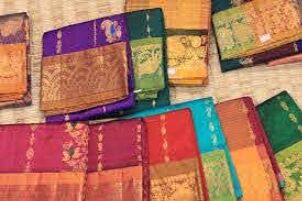State seeks GI status for three varieties of traditional sarees

Kolkata: The Mamata Banerjee government has initiated the process of seeking GI (Geographical Indication) status for Tangail Jamdani, Korial and Garad—all traditional variant of sarees. There are six traditional sarees belonging to the state among which GI has already been received for Santipuri, Dhaniakhali and Baluchari variety.
"The application for filing towards registration for the three traditional sarees namely Tangail Jamdani (West Bengal variety), Korial and Garad have been sent to the state Science and Technology Department during the month of March, 2020," said an official of state MSME & Textiles department.
The Tangail Jamdani ( West Bengal variety) is manufactured at Dhatrigram, Samudragarh in East Burdwan & Fulia and Nakashipara in Nadia district while Korial and Garad is made in the district of Murshidabad.
Jamdani is the technique used to decorate the plain mulmul, muslin, with the addition of supplementary extra cotton wefts, to create dense patterning against a semi-transparent background. The traditional weaving centres for Jamdani in Bengal are Fulia and Beldanga in the district of Nadia, and Saptagram, Tamaghata, Dhatrigram, in the district of Burdwan. About 5,000 weavers are engaged in the production of such sarees with an annual estimated turnover of Rs 150 crore.
The Tangail saree exemplifies most graphically the travails of the weaving community of the two Bengal. Tangail, which is a village in what is today known as Bangladesh, was the home of weavers, who later moved to Fulia in Nadia district, because of Partition. The traditional Tangail borders had a "paddo" or lotus pattern, predeep, or lamp pattern or the lata-pata vine pattern apart from the popular aansh paar which was common to the Shantipuri tradition. From the use of a single colour on the border, they began to use two or three colours on the borders from a "meenakari" effect. About, 100,000 weavers are engaged in the production of Tangail and Tangail Jamdani with an annual estimated turnover of Rs 1500 crore.
The Garad silk saree consists of plain borders, set against a natural ground with widely spaced red kalka or paisley motifs scattered diagonally. The Korial lal paar saree is identical to the Garad except that the red of the Korial border is intense and solid. The weaving and wearing of these sarees is associated with Durga Puja .
An official in the Textiles department said that GI tag for a product is important as the status fetches more price in international market ." It results in boost in export and tourism too. Most importantly, the poor artisans from the given region have to face less competition from fake guys selling bogus products. It indirectly leads to sustainable development," added the official.



